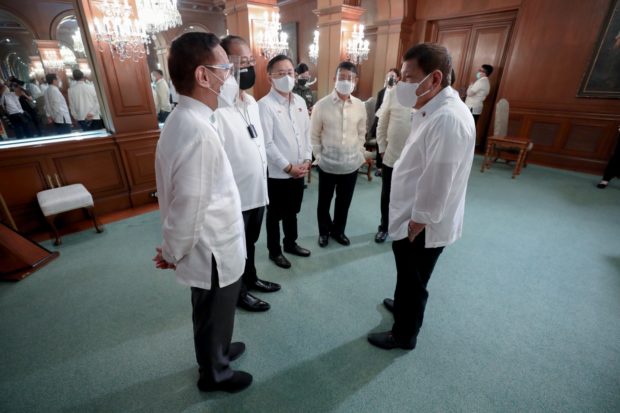MANILA, Philippines — With fewer and fewer people allowed to approach President Duterte physically or attend his events because of pandemic restrictions, the number could become even smaller once the Presidential Security Group (PSG) imposes its plan to require everyone to be fully vaccinated before getting close to him.
In addition to the required health protocols, visitors of the President and those who will join his activities must show they are free of the coronavirus through a rapid test plus the “gold standard” RT-PCR (reverse transcription-polymerase chain reaction) test favored by the Department of Health (DOH).
This has been the policy since April last year.
“Time will come, we will adjust to that and we would require all those who would get close to or attend events of the President [to be] fully vaccinated,” PSG Commander Brig. Gen. Jesus Durante III said on Friday.
Upcoming Sona
“But for now, we still adhere and still implement our health and security protocols,” Durante told state-run PTV television.
The next major public event of the President is his last State of the Nation Address (Sona) to Congress in July.
Durante said there would be few in-person attendees, just like last year.
“Some will attend through, and there will be a minimal number of attendees in the plenary, and everybody will be subjected to the health and safety protocols the PSG will implement. This is for everybody’s safety,” he said.
It was unclear from Durante’s statement whether the no-vaccination, no-entry policy would be implemented at the Batasang Pambansa, where Duterte delivered his Sona last year with only 50 guests physically present.
Durante said Duterte had been fully vaccinated. The President received his first dose of the China-made Sinopharm vaccine on May 3.
Correction
But presidential spokesperson Harry Roque corrected him, saying that Durante was “mistakenly informed by his medical staff” that Duterte had received his second dose.
Roque said the general apologized and rectified his earlier remarks.
Unknown to health authorities, the Sinopharm vaccine was brought into the country around September and October last year and was first administered to the President’s close-in security detail.
It received an emergency use authorization from the Food and Drug Administration (FDA) only early this month.
The FDA said the PSG was not cooperating with its investigation of how the vaccine entered the country.
More than 2.15 million people had been fully vaccinated since the national vaccination program was rolled out in March. The goal is to inoculate 50 million to 70 million Filipinos by the end of this year.
Milestone in sight
As of June 22, the government had administered 8.93 million doses of various vaccines against COVID-19, according to Secretary Vince Dizon, deputy chief implementer of the National Task Force Against COVID-19.
Dizon said the government was able to administer 350,000 shots per day on June 23 and June 24, the highest number in a day.
“We are confident that next week, we would reach the very important milestone, where we would hit 10 million,” he said at Friday’s Laging Handa briefing.
“We will continue to see an increase in the vaccinations conducted daily,” he said.
The mass immunization drive prioritizes highly urbanized areas with a high number of cases, particularly the National Capital Region (NCR), Pampanga, Bulacan, Cavite, Batangas, Laguna, Rizal, Metro Cebu and Metro Davao, collectively called the NCR Plus area.
Dizon said these areas were prioritized due to the high possibility that they would be experiencing a surge in cases and that they contribute significantly to the economy.
But he said the government had expanded the priority areas to include the cities of Bacolod, Iloilo, Cagayan de Oro, Baguio, Dumaguete, Tuguegarao, General Santos, Naga and Legazpi.
“As more vaccines arrive, we would continue to add to our priority areas,” he said.
DOH case update
The DOH on Friday recorded 6,812 new COVID-19 cases, which brought the national caseload to 1,385,053.
It said 2,867 had recovered, increasing the number of survivors to 1,305,608. But the 116 who had died, raised the death toll to 24,152.
The recoveries and deaths left 55,293 active cases. Of the total, 90.8 percent are mild cases, 4.6 percent asymptomatic, 1.9 percent severe, 1.3 percent critical and 1.35 percent moderate.
The DOH said it had removed 19 duplicate cases from the total case count and 61 cases previously tagged as recoveries had been reclassified as deaths after validation. —WITH REPORTS FROM PATRICIA DENISE M. CHIU AND INQUIRER RESEARCH INQ
